The Archaeological Institute of America - Jacksonville Society
The Archaeological Institute of America (AIA) is the world's oldest and largest archaeological organization. The AIA is a nonprofit founded in 1879 and chartered by the United States Congress in 1906. There are more than 100 local societies, like this Jacksonville Society, in the United States, Canada, and overseas. Members include professional archaeologists, students, and enthusiasts, all united by their passion for archaeology and its role in furthering human knowledge.
The AIA promotes archaeological inquiry and public understanding of the material record of the human past to foster an appreciation of diverse cultures and our shared humanity.
The AIA supports archaeologists, their research and its dissemination, and the ethical practice of archaeology.
The AIA educates people of all ages about the significance of archaeological discovery and advocates for the preservation of the world’s archaeological heritage.
Professional archaeologists who are AIA members, have conducted fieldwork worldwide. The Institute has founded research centers and schools in seven countries and maintains close contact with these institutions. AIA Members are dedicated to the greater understanding of archaeology, the protection and preservation of the world's archaeological resources, and the support of archaeological research and publication.
___________________________________________________________________________________________________________________________________________________
The Archaeological Institute of America—Jacksonville Society and the Beaches Museum in Jacksonville Beach are sponsoring an archaeological fair to celebrate International Archaeology Day on Oct. 19, 2024. The fair will take place at the Museum (381 Beach Blvd.) from 10 a.m. until 2 p.m. and will include demonstrations of how ancient inhabitants made rope from plants and how they made ceramic items from clay. Dr. Amanda Hall from the Florida Museum of Natural History in Gainesville will be available to identify local artifacts as well as to explain artifacts from the museum on display. Children will be able to participate in a simulated archaeology dig and make pots of their own. Displays by the Museum of Science and History and the Master Gardeners will be presented. A free lecture by Dr. Adam King from the University of South Carolina will take place at noon in the historic chapel. The title of King’s lecture is “The Rise of Etowah: Creating Community, Place, and Identity.”
The event is free and open to the public.
___________________________________________________________________________________________________________________________________________________
SEASONAL LECTURES
Our speaker presentations take place at noon, in Building 51 at the University of North Florida, Jacksonville, (1 UNF Dr, Jacksonville, FL 32224). Email [email protected] to find out if Zoom is offered for each lecture. The lectures are free and open to the public. After the lecture, complimentary refreshments may be served in the Physical Anthropology Lab. On Saturdays, parking is free and the staff/faculty/vendor spaces are open to everyone.
2024 MEETINGS & PRESENTATIONS
THIS LECTURE TO TAKE PLACE AT THE BEACHES MUSEUM FOR INTERNATIONAL ARCHAEOLOGY DAY
Dr. Adam King from the University of South Carolina
The Rise of Etowah: Creating Community, Place, and Identity

The Etowah site is one of the best-known 14th century Indigenous ritual centers in the Deep South. As a place, Etowah began in the 12th century when local people and immigrants from neighboring regions brought together a unique set of practices and ideas to create a new kind of community. By the start of the 14th century, an influx of new people and ideas ushered in Etowah’s rise to prominence as its architects transformed their landscape to create an impressive ritual and political center. Within a few generations, an attack by an unknown enemy ended that reign when they burned the Etowah community and severed its connection to the sacred. In this talk, Dr. King explores how the people who built Etowah used everyday things, monuments, and the sacred to forge a sense of place, history, and identity. LEARN MORE ABOUT ETOWAH MOUNDS STATE HISTORIC SITE
Adam King is a Research Associate Professor in the Research Division. His research interests center on variation in the organization of Mississippian period societies in the Deep South. He is currently pursuing projects in the Etowah River Valley of northwestern Georgia and the middle Savannah River Valley on the Georgia-South Carolina border. In the Etowah Valley, he is working on reconstructing the history of the polities associated with the famous Etowah site. Current projects include 1. creating GIS layers and a relational database to analyze the extensive mortuary data from Etowah's Mound C, 2. exploring beliefs about the sacred and their intersection with social inequality through the study of Mississippian art and iconography, and 3. investigating the layout of the Etowah site through full cover remote sensing surveys. In the Savannah Valley, he is exploring the histories of four small centers and associated polities through examination of town layout and settlement distributions.
 Laura Seifert,
Laura Seifert,
Savannah Archaeological Alliance
Faith in Education at the Skidaway Island Benedictine Mission
Following emancipation, education was considered an urgent priority in the African American community. Laura Seifert's forthcoming book follows the Benedictine contributions and blunders in Black education and Savannahians’ negotiations of those efforts. She will discuss her archaeological excavations at the Benedictine's Skidaway Island, Georgia, school.
ABOUT THE BOOK:
Having survived the turmoil of Reconstruction, several hundred African American tenant farmers were settled on Skidaway Island, Georgia, and led a fairly quiet existence. In 1877 Benedictine monks intruded into this relatively safe, if desperately poor, haven and built a Catholic mission and boys’ boarding school. For the next two decades, the Benedictines and locals negotiated for influence over the islanders’ religious convictions and education.
Faith in Education at the Skidaway Island Benedictine Mission brings together the recovered archaeological data and extensive Benedictine archives to reconstruct the intersecting lives of monks, students, lay brothers, and African American neighbors on Skidaway Island. Unlike a purely historical treatment, this book amplifies the documentary evidence with archaeological findings, including glass from arched church windows, writing slate and slate pencil fragments, a kerosene lamp, and harmonica fragments.
The narrative balances the chronological story of the Skidaway Island mission with the larger history of African American education in Savannah and Chatham County from 1865 to the mission’s closure circa 1900. Ultimately, Laura Seifert’s analysis shows how the roots of our educational system resulted in inequities today, particularly because racism is a prominent thread that connects past and present problems.
Savannah Archaeological Alliance Founder Laura Seifert has nearly 20 years of experience in archaeology, museums, and higher education. Seifert has spent her career working on archaeology projects from the Canadian border to the Caribbean, with a focus on public archaeology, museums, and the southeastern United States. Ms. Seifert has worked at diverse museums such as Mount Vernon and St. Mary’s City and taught at the Armstrong Campus of Georgia Southern University for seven years (or two name changes). As an Instructor of Anthropology at the Armstrong Campus of Georgia Southern University, she has developed five new archaeology courses in past seven years. Seifert also co-founded and directed Digging Savannah, Armstrong’s public archaeology program. Digging Savannah projects included smartphone apps for exploring archaeology in Savannah, a lecture series, walking tours, and excavations at the Sorrel-Weed House and Skidaway Island’s Benedictine Monastery and Freedmen School. Ms. Seifert’s full CV is available here.
Dr. Thomas Pluckhahn, University of South Florida
Historical Ecology Reveals the “Surprising” Direction and Extent of Shifting Baselines for the Florida Manatee
 Biologists are increasingly aware of the problem of “shifting baselines”: our accepted norms regarding the range and abundance of animal species change from one generation to the next. Historical ecological studies—drawing from archaeological and historical data—demonstrate the surprising extent to which contemporary assumptions misrepresent premodern baselines, generally by greatly underestimating losses that have taken place in the Anthropocene. However, in at least a few cases, historical ecologists have revealed that our baselines sometimes overestimate premodern species abundance. I suggest that such may be the case for the Florida manatee, a subspecies of the West Indian manatee found primarily in Florida, USA.
My reviews of archaeological and historical records suggest that manatee populations in Florida were very small in the Precolonial and Colonial Periods, possibly representing infrequent in-migration from the Caribbean during favorable climate conditions. Manatees expanded in number and range across the Florida peninsula during the Territorial/Early Statehood and Early Modern Periods, first northward on the Atlantic Coast and later along the coast of the Gulf of Mexico. These expansions track increasing human populations, associated anthropogenic landscape alterations, and social and policy changes. Historical ecology is critical for “shaping a better Anthropocene” for humans and manatees in Florida.
Biologists are increasingly aware of the problem of “shifting baselines”: our accepted norms regarding the range and abundance of animal species change from one generation to the next. Historical ecological studies—drawing from archaeological and historical data—demonstrate the surprising extent to which contemporary assumptions misrepresent premodern baselines, generally by greatly underestimating losses that have taken place in the Anthropocene. However, in at least a few cases, historical ecologists have revealed that our baselines sometimes overestimate premodern species abundance. I suggest that such may be the case for the Florida manatee, a subspecies of the West Indian manatee found primarily in Florida, USA.
My reviews of archaeological and historical records suggest that manatee populations in Florida were very small in the Precolonial and Colonial Periods, possibly representing infrequent in-migration from the Caribbean during favorable climate conditions. Manatees expanded in number and range across the Florida peninsula during the Territorial/Early Statehood and Early Modern Periods, first northward on the Atlantic Coast and later along the coast of the Gulf of Mexico. These expansions track increasing human populations, associated anthropogenic landscape alterations, and social and policy changes. Historical ecology is critical for “shaping a better Anthropocene” for humans and manatees in Florida.Alex Diaz, Master Student, Florida State University
Crafting Bones: An Analysis of a Worked Bone Assemblage from a Mississippian Mound Complex in Northeast Florida

Bone has been used as a medium for crafting both tools and decorative items since our earliest ancestors; however, this important component of material culture has often been overlooked. The analysis of the worked bone assemblage recovered from the excavations at the Mill Cove Complex has the potential to provide insights into the role of worked bone within a unique ritual context. Diaz worked to create a typology using a multi-analytical approach to highlight the relationships between form and function supported by use-wear and macro fracture analysis to provide insights into the manufacturing, use, and discard of the worked bone artifacts recovered from the site. The data gathered from this study has contributed to a better understanding of the role worked bone played within ritual contexts among the pre-contact communities along Florida’s Northeast coast.
Dr. Tate Paulette from North Carolina State University
When Beer Flowed Like Wine: Beer and Brewing in Bronze Age Mesopotamia
 We may be living in the age of craft brewing, but the craft of brewing has much deeper roots. For thousands of years, people have been intentionally fermenting cereal grains to create their own unique versions of the intoxicating beverage that we now call beer. In ancient Mesopotamia, beer was produced on a massive scale and was consumed on a daily basis by people across the socio-economic spectrum. Beer was a gift from the gods, a marker of civilization, a dietary staple, a social lubricant, a ritual necessity, and a reason for celebration. It was consumed at feasts, festivals, and ritual ceremonies, but also at home, on the job, and in neighborhood taverns. It was produced by brewers working for the powerful palace and temple institutions and also by local tavern keepers and homebrewers. This lecture explores the archaeological, artistic, and written evidence for beer and brewing in Bronze Age (3000–1200 BC) Mesopotamia, as well as recent efforts to recreate Mesopotamian beer.
We may be living in the age of craft brewing, but the craft of brewing has much deeper roots. For thousands of years, people have been intentionally fermenting cereal grains to create their own unique versions of the intoxicating beverage that we now call beer. In ancient Mesopotamia, beer was produced on a massive scale and was consumed on a daily basis by people across the socio-economic spectrum. Beer was a gift from the gods, a marker of civilization, a dietary staple, a social lubricant, a ritual necessity, and a reason for celebration. It was consumed at feasts, festivals, and ritual ceremonies, but also at home, on the job, and in neighborhood taverns. It was produced by brewers working for the powerful palace and temple institutions and also by local tavern keepers and homebrewers. This lecture explores the archaeological, artistic, and written evidence for beer and brewing in Bronze Age (3000–1200 BC) Mesopotamia, as well as recent efforts to recreate Mesopotamian beer.
Dr. Tate Paulette studies urban food systems in the ancient world. A native of North Carolina, he holds an MA and PhD in Near Eastern Archaeology from the University of Chicago and an MA in Archaeology from the University of Edinburgh. His research explores agricultural practices, gastro-politics, and state making in the world’s first cities and states, with a focus on Mesopotamia and the Near East. He also studies ancient alcohol, and he has spearheaded a collaborative effort to recreate Sumerian beer using authentic ingredients, equipment, and brewing techniques.
Dr. Sarah Freidline, University of Central Florida
Recent advances in human origins research: new insights from Northern Africa to Southeast Asia
 New technologies and methodological approaches in the last decades have led to exciting advances in paleoanthropology—especially concerning the origin of our species, dated to roughly 300,000 years ago, and our subsequent dispersions out of Africa. Current fossil and genomic data suggest that we were not the only members of our genus alive during this time. In this talk, I will discuss recent advances and pending questions in human origins research, focusing on my work on some of the earliest Homo sapiens fossils from Northern Africa (Jebel Irhoud, Morocco) and Southeast Asia (Tam Pà Ling, Laos), as well as our enigmatic cousins, the Denisovans.
New technologies and methodological approaches in the last decades have led to exciting advances in paleoanthropology—especially concerning the origin of our species, dated to roughly 300,000 years ago, and our subsequent dispersions out of Africa. Current fossil and genomic data suggest that we were not the only members of our genus alive during this time. In this talk, I will discuss recent advances and pending questions in human origins research, focusing on my work on some of the earliest Homo sapiens fossils from Northern Africa (Jebel Irhoud, Morocco) and Southeast Asia (Tam Pà Ling, Laos), as well as our enigmatic cousins, the Denisovans.
Dr. Freidline is a biological anthropologist who specializes in paleoanthropology. Her research focuses on the evolution and development of human craniofacial morphology. She applies state-of-the-art methods to interpret craniofacial growth in fossil species ranging from Homo erectus to H. neanderthalensis and H. sapiens with the ultimate goal of better understanding the evolution of the H. sapiens face. Freidline combines geometric morphometric methods and surface histology to quantify macro and microscopic shape changes. Furthermore, as fossil bones are nearly always damaged, a large part of her work consists of virtual fossil reconstruction.
Sarah received her Ph.D. in 2012 working jointly at the City University of New York (CUNY) Graduate Center and the Max Plank Institute for Evolutionary Anthropology (MPI-EVA) in Leipzig, Germany. From 2012 to 2020, she worked as a post-doctoral researcher at the MPI-EVA in the Department of Human Evolution.
Dr. Charles Cobb from the Florida Museum of Natural History at the University of Florida
Following the Metal Wake of Spanish Expeditions in the Southeast
 Many of the artifacts from 16th-century Spanish explorations found on Native American sites in the American Southeast have been documented from burial contexts. This has given rise to the received wisdom that these objects were usually gifts distributed to Indigenous elites. Over the past decade, archaeological research at sites in Mississippi, Alabama, and Georgia has challenged this perspective. Systematic-metal detecting surveys have revealed that objects of European origin are far more abundant than previously realized and are often found in domestic contexts. This work is opening up new interpretations about how Native Americans acquired European goods, as well as how they modified these objects in ways that aligned with Indigenous worldviews.
Many of the artifacts from 16th-century Spanish explorations found on Native American sites in the American Southeast have been documented from burial contexts. This has given rise to the received wisdom that these objects were usually gifts distributed to Indigenous elites. Over the past decade, archaeological research at sites in Mississippi, Alabama, and Georgia has challenged this perspective. Systematic-metal detecting surveys have revealed that objects of European origin are far more abundant than previously realized and are often found in domestic contexts. This work is opening up new interpretations about how Native Americans acquired European goods, as well as how they modified these objects in ways that aligned with Indigenous worldviews.
Charles Cobb has been the Curator of Historical Archaeology at the Florida Museum of Natural History since 2014. He also is Director of the Museum’s Randell Research Center located on Pine Island in southwest Florida. He received his PhD in 1988 from Southern Illinois University and was subsequently a faculty member in anthropology at SUNY-Binghamton and University of South Carolina before his arrival at the University of Florida. Cobb has a long-term interest in the history and archaeology of Indigenous cultures of the southeastern United States, with a particular focus on interactions between Native Americans and European colonials. Since his arrival at Florida, he has been developing an online digital database of Florida Museum artifact collections from St. Augustine and Franciscan mission sites. Meanwhile, his field projects have had two emphases: first, addressing the impacts of Spanish expeditions on Native American societies during the 1500s A.D.; second, investigating the widespread abandonment of Indigenous towns in the mid-South during the 1400s A.D. Since 2015, his fieldwork has been carried out in collaboration with the Chickasaw Nation.
MAKE A DONATION
A donation of any amount helps us with speaker presentations. Just click the secure “DONATE” button below to use your credit card or PayPal account.
All of us enjoy the speakers and presentations that showcase the fascinating scope of archaeology in these exciting times of discovery and technological change. Your gift assists with expenses incurred by the visiting scholars and archaeologists at our events.
Thank you for your consideration and support!

AIA MEMBERSHIP
Join the Archaeological Institute of America, the world’s largest and oldest archaeological organization today, and be connected with thousands of other members who share your passion for archaeology!
Connect with thousands of members who share your passion for archaeology.
Participate in local events through an AIA Local Society.
Receive exclusive MEMBER BENEFITS.
Members like you support excavation, preservation, outreach, education, advocacy, and the professional activities of the AIA.
RECENT ARCHAEOLOGY NEWS

Additional Moche Murals Uncovered in Peru at Pañamarca
CHIMBOTE, PERU—According to an ArtNet News report, the seventh-century A.D. throne room of a female ruler has been discovered in northwestern Peru at the Moche site of Pañamarca by researchers from the Archaeological Landscapes of Pañamarca, the Denver Museum of Nature & Science, and Columbia University. The room has been dubbed the Hall of the Moche Imaginary for its paintings, which are said to shed light on Moche beliefs and practices. The throne itself, made of painted adobe, is surrounded by walls and pillars painted with scenes depicting women spinning and weaving, a procession of men carrying a crown, sea creatures, a crowned woman raising a goblet, and a woman sitting on the throne speaking to a bird-man. The team members have also uncovered the monumental Hall of the Braided Serpents, which overlooks a plaza. Its pillars are decorated with images of intertwined snakes and humans, warriors, weapons, and monsters. For more on Pañamarca, go to "Painted Worlds."

17th-Century Home Site Excavated in Massachusetts
DEARBORN, MICHIGAN—The site of the seventeenth-century home of John Doane, one of the first English families to settle in what is now the town of Eastham, Massachusetts, has been excavated by John Chenoweth of the University of Michigan-Dearborn and his colleagues, according to a report in The Provincetown Independent. Doane died in 1686 at the age of 94, after serving as the town’s deacon, constable, surveyor of highways, deputy to the colony court, and selectman. After his death, his daughter Abigail, who had been living with him, married and moved to Connecticut, likely taking the most valuable goods in the home with her. Thousands of chips from expensive imported bricks uncovered at the site suggest that the house had a hearth, cellar, chimney, and footings made of brick. Fragments of flat glass and X-shaped lead window framing indicate that the house had glass windows. “Glass is a real status symbol in seventeenth-century New England,” Chenoweth said, since it was so fragile and had to be transported from England. Yet poor-quality pieces of molten glass and several pieces of iron slag could reflect an attempt to repair or produce goods locally, he added. Few pieces of bottle glass and pipestems were unearthed, perhaps reflecting little consumption of alcohol or tobacco by Doane, who was remembered as “a man of wisdom, integrity, and deep piety,” according to a history of the region compiled in the mid-nineteenth century. To read about the recently uncovered eighteenth-century homestead of a prominent Black property owner in New England, go to "Around the World: Massachusetts."
CURRENT ARCHAEOLOGY MAGAZINE
Click the cover image for more details

Ancient DNA Revolution
How the rapidly evolving field of archaeogenetics is unlocking secrets of the past
Hunting for the Lost Temple of Artemis
After a century of searching, a chance discovery led archaeologists to one of the most important sanctuaries in the ancient Greek world
Trees of the Sky World
Why Australia’s Indigenous Wiradjuri people carved sacred symbols into trees to mark burials of their honored dead
The People Before the Book
A trove of papyri unearthed on the Egyptian island of Elephantine gives voice to an early Jewish community
Pompeii Style
Inside the Roman houses where archaeologists continue to discover evocative new masterpieces



